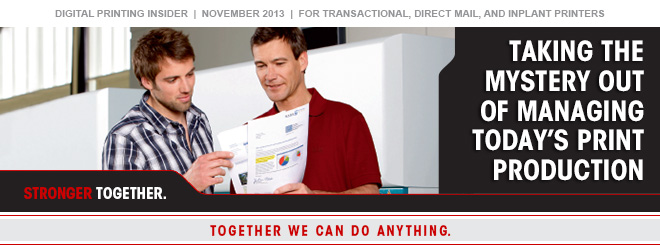Inkjet and Direct Mail Marketing: What’s the Hook?
Direct marketers know all about the hook – that short little catch-phrase that grabs the consumer’s interest and maybe even justifies the purchase. When positioning inkjet to the transaction printing market the hook is easy:

If you’re in the direct mail or collateral fulfillment business, the hook is not so simple.
Yes, direct marketers can save money with inkjet relative to the running cost of toner-based presses, however there are not the same opportunities to eliminate preprinted stocks, standardize on one or two stocks, or combine mailings that transaction printers do. In fact, some direct marketers have linearized over two dozen stocks for production on their inkjet presses and regularly run jobs on six or seven different stocks.
For this market, the opportunity really lies in what inkjet allows marketing services providers to do for their clients. As clients hunger for more personalization, inkjet delivers full color personalization at a reasonable price. Toner presses with similar quality can’t meet the cost or time-to-market constraints of major mailers. Web presses offer volume and quality but can’t meet personalization or time to market demands. Inkjet fills the gap and of what toner presses and web presses cannot and provides a “best of both worlds” scenario. Maybe that’s the hook: “fast, high-quality personalization at a reasonable cost.”
ARE YOU HOOKED?
If you want to be able to offer more personalized pieces to your clients in a high-speed environment using a broad array of media, there is an inkjet solution that is right for you. The next challenge will be finding the configuration that makes sense for your mix of business.
If you are using many different types of paper, controlling paper wastage will be critical. Look for a press that offers printing during ramp up. If you are printing coupons or convenience checks you’ll want integrated, high-speed MICR and possibly fugitive ink. Then there is the question of the type of ink to use, dye or pigment.
Some might argue for pigment ink in the direct marketing arena because more of the colorant stays on top of the paper, giving a brighter appearance. Pigment also allows for a somewhat heavier Total Area Coverage (TAC) with less potential for bleed through than with dye – the major detractor from pigment being that it has a smaller color gamut than dye and it can take a bit longer to dry. Fast immobilizing pigment inks solve the drying problems and enable even heavier coverage while the addition of spot colors can help to address gamut issues.
The argument for dye inks includes a wider color gamut, which can be further expanded through spot colors for specific brand matching and lower cost for many applications. Since dye colorants are absorbed into the paper and can’t be scratched off of the surface, dye-based pieces tend to be more durable. In the end, there is really no best solution; the pigment/dye evaluation needs to be made based on your expected mix of jobs and the papers that you want to use.
When you’ve finished thinking about ink you will need to start to think about finishing. Folding, binding and perforating equipment has become increasingly sophisticated. Your finishing needs will have an impact on the paper width you select for your press as well as the optimal inline, near line or offline finishing configuration. Having an inkjet partner that will also support the finishing configuration can be a real plus when it comes to getting a complex line implemented and keeping it running smoothly.
GETTING CUSTOMERS HOOKED
With the increasing array of inkjet papers available, there are so many great options for ink and sophisticated finishing options. You can now offer clients tremendous creativity and personalization as well as super-fast turn times. If you can use inkjet to get your clients hooked on full color personalization and the boost in response it drives, there’s no doubt you’ll be hooked on the margins you can achieve from this printing technology.
INKJET APPLICATION GUIDE
With so many high-speed inkjet options on the market, you want to be sure that you are investing in a machine that is well-positioned for your company’s applications. We created this Inkjet Application Guide to help you with just that. This guide showcases our depth in inkjet technology across a wide variety of applications. Whether you are printing premium direct mail pieces or marketing collateral, we have the application for you. For each segment and application, this guide provides information about:
- Segment and description of application
- Added value through digital print
- Screenshot of the application
- Paper and printer settings used
- TrueProof coverage information
XPLOR WEBINAR: PRINT PRODUCTION MANAGEMENT
Managing print production can be quite the challenge these days, especially as the number of jobs increase and the volumes decrease. Throw color into the mix and things become even more interesting. Then there is the decision of what to print on, cut sheet or continuous, toner or inkjet, in-line or near line. Keeping all of this straight and staying on point daily is a task that can only be maintained through the use of intelligent, integrated workflow solutions.
